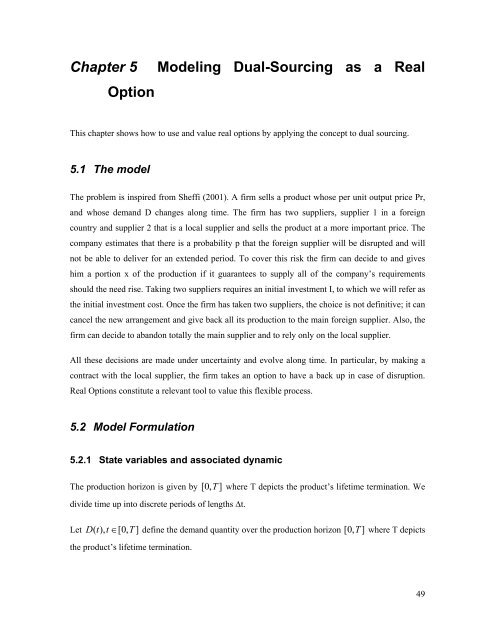Managing Risks of Supply-Chain Disruptions: Dual ... - CiteSeerX
Managing Risks of Supply-Chain Disruptions: Dual ... - CiteSeerX
Managing Risks of Supply-Chain Disruptions: Dual ... - CiteSeerX
Create successful ePaper yourself
Turn your PDF publications into a flip-book with our unique Google optimized e-Paper software.
Chapter 5OptionModeling <strong>Dual</strong>-Sourcing as a RealThis chapter shows how to use and value real options by applying the concept to dual sourcing.5.1 The modelThe problem is inspired from Sheffi (2001). A firm sells a product whose per unit output price Pr,and whose demand D changes along time. The firm has two suppliers, supplier 1 in a foreigncountry and supplier 2 that is a local supplier and sells the product at a more important price. Thecompany estimates that there is a probability p that the foreign supplier will be disrupted and willnot be able to deliver for an extended period. To cover this risk the firm can decide to and giveshim a portion x <strong>of</strong> the production if it guarantees to supply all <strong>of</strong> the company’s requirementsshould the need rise. Taking two suppliers requires an initial investment I, to which we will refer asthe initial investment cost. Once the firm has taken two suppliers, the choice is not definitive; it cancancel the new arrangement and give back all its production to the main foreign supplier. Also, thefirm can decide to abandon totally the main supplier and to rely only on the local supplier.All these decisions are made under uncertainty and evolve along time. In particular, by making acontract with the local supplier, the firm takes an option to have a back up in case <strong>of</strong> disruption.Real Options constitute a relevant tool to value this flexible process.5.2 Model Formulation5.2.1 State variables and associated dynamicThe production horizon is given by [ 0, T ] where T depicts the product’s lifetime termination. Wedivide time up into discrete periods <strong>of</strong> lengths ∆t.Let D( t),t ∈ [0, T ] define the demand quantity over the production horizon [ 0, T ] where T depictsthe product’s lifetime termination.49
















